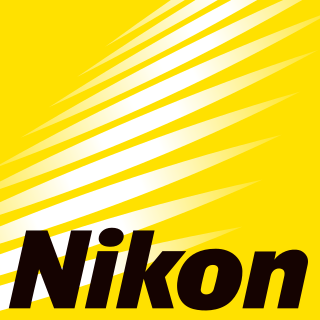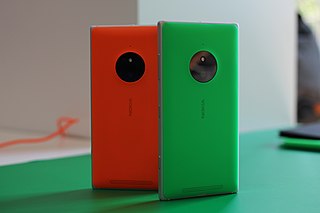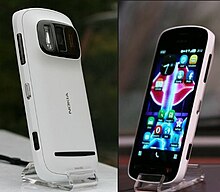
A digital camera, also called a digicam, is a camera that captures photographs in digital memory. Most cameras produced today are digital, largely replacing those that capture images on photographic film. Digital cameras are now widely incorporated into mobile devices like smartphones with the same or more capabilities and features of dedicated cameras. High-end, high-definition dedicated cameras are still commonly used by professionals and those who desire to take higher-quality photographs.

A smartphone is a mobile device that combines the functionality of a traditional mobile phone with advanced computing capabilities. It typically has a touchscreen interface, allowing users to access a wide range of applications and services, such as web browsing, email, and social media, as well as multimedia playback and streaming. Smartphones have built-in cameras, GPS navigation, and support for various communication methods, including voice calls, text messaging, and internet-based messaging apps.

A camera lens is an optical lens or assembly of lenses used in conjunction with a camera body and mechanism to make images of objects either on photographic film or on other media capable of storing an image chemically or electronically.

A camera phone is a mobile phone which is able to capture photographs and often record video using one or more built-in digital cameras. It can also send the resulting image wirelessly and conveniently. The first commercial phone with color camera was the Kyocera Visual Phone VP-210, released in Japan in May 1999.

Nikon Corporation is a Japanese optics and photographic equipment manufacturer headquartered in Tokyo, Japan. The companies held by Nikon form the Nikon Group.

The Nokia N93 is a mobile phone from Nokia, part of the multimedia Nseries. It was introduced on 25 April 2006 and released in July 2006. It runs on Symbian OS v9.1 and the S60 3rd Edition interface. It was the most advanced camera phone from Nokia at the time of its release, and was particularly marketed for its swivel design like its predecessor Nokia N90, which mimics the appearance of a conventional camcorder.

In digital photography, the image sensor format is the shape and size of the image sensor.

The Nokia N86 8MP is a high-end mobile phone with emphasis on the camera. It was announced on 17 February 2009 and released in May 2009 as part of the Nseries. It runs on Symbian OS 9.3 and shares similar design features with the N97. Its name references the camera's megapixel count.

The Nokia N8 is a touchscreen-based smartphone developed by Nokia. Announced on 27 April 2010, the Nokia N8 was the first device to run on the Symbian^3 mobile operating system and it was the company's flagship device for the year. It was released on 30 September 2010 at the Nokia Online Store before being released in markets around the world on 1 October 2010. There were two versions made, the N8 and the N8-00. The N8 was made for Vodafone and locked to its networks, and the N8-00 was made by Microsoft and open network.
The Nokia C6-01 is a Symbian^3 smartphone from the Nokia Cseries. The C6-01 display features comes with a 3.2in AMOLED display with capacitive touchscreen capabilities and Nokia's ClearBlack technology for improved outdoor visibility. The smartphone was released on November 4, 2010 for €260, excluding taxes and subsidies.

The Panasonic Lumix DMC-GH2 is a digital camera with HD video recording capability that is part of the Micro Four Thirds system. Though commonly referred to as a DSLR camera, it has no mirror or optical viewfinder, but has instead both a fold-out LCD screen and a electronic viewfinder.

The Nokia 603 is an entry level Symbian Belle smartphone by Nokia. It was announced on 13 October 2011. It ships with the Symbian Belle OS. Later with the release of Nokia 808 PureView, an update of Belle Feature Pack 2 was released for the phone. Nokia 603 is a low-cost device featuring a 3.5-inch ClearBlack display, 1.0 GHz processor, and NFC.

Nokia PureView is the branding of a combination of technologies used in cameras of Nokia-branded smartphones, and previously, in phones by Microsoft Mobile. PureView was first introduced with Nokia 808 PureView.

The Nokia Lumia 1020 is a smartphone developed by Nokia, first unveiled on 11 July 2013 at a Nokia event in New York. It runs Windows Phone 8, but is also Windows Phone 8.1 ready. It contains Nokia's PureView technology, a pixel oversampling technique that reduces an image taken at full resolution into a lower resolution picture, thus achieving higher definition and light sensitivity, and enables lossless digital zoom. It improves on its predecessor, the Nokia 808, by coupling a 41-megapixel 2/3-inch BSI sensor with optical image stabilization (OIS) and a high resolution f/2.2 all-aspherical 1-group Carl Zeiss lens. It was considered to be the most advanced cameraphone when released in September 2013.

The Samsung Galaxy S4 Zoom is a smartphone with a camera hybrid, with 10x optical zoom and a f/3.1-6.3 lens with built-in optical image stabilizer and a standard xenon flash. It was introduced in July 2013.

The Nokia Lumia 830 is a smartphone developed by Microsoft Mobile and branded as "Nokia" that runs Microsoft's Windows Phone 8.1 operating system. It was announced on September 4, 2014 at Internationale Funkausstellung Berlin and released in October 2014. It is a successor to the 2012 Nokia Lumia 820 and marketed as an "affordable flagship".

The Nokia Lumia 730 is a smartphone developed by Microsoft Mobile and branded as "Nokia" that initially runs Microsoft's Windows Phone 8.1 operating system. It was announced on September 4, 2014 at Internationale Funkausstellung Berlin and released in October 2014. It is a successor to the 2013 Nokia Lumia 720 and marketed as a selfie phone.

The Nokia 9 PureView is a Nokia-branded flagship penta-camera smartphone developed by HMD Global. It was introduced at the 2019 Mobile World Congress (MWC) in Barcelona, Spain as a successor to the Nokia 8 Sirocco. It alludes to Nokia's previous camera-centric PureView devices, which ended with the Lumia 950 and 950 XL. Like most of HMD's Nokia smartphones of the time, the 9 PureView is part of the Android One program.
The Nokia 7.2 is an Android smartphone produced by HMD Global. The 7.2 was announced on September 6th, 2019 at IFA and prices at launch started at $349 (£249) for the cheapest model.

The Sony Xperia 1 IV is an Android smartphone manufactured by Sony. Launched on May 11, 2022, it succeeds the Xperia 1 III as the latest flagship of Sony's Xperia series. The device was announced along with the mid-range Xperia 10 IV, with expected release dates by June 2022 and as late as September 2022 for other markets including the US. US shipments were delayed and ultimately began in late October 2022.





















